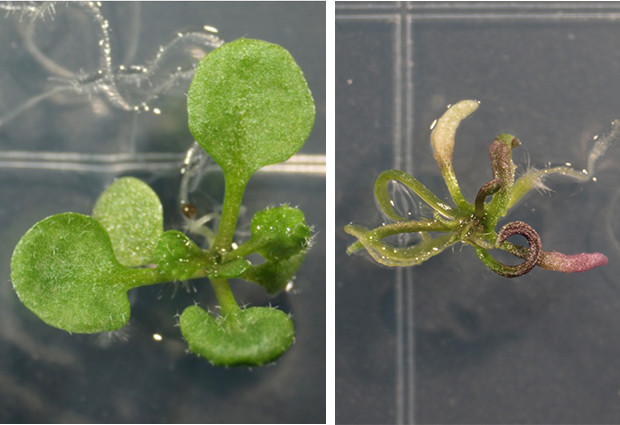In pursuit of flat growth in leaves

If the molecular balance is disturbed, leaves grow stem-like (right), instead of flattening out. PHOTO: Paz Merelo/EMBL
As a leaf develops, its cells create two different tissues, one on each side of the leaf. Scientists knew that only cells in the top side produce proteins called Class III HD-ZIPs. In the bottom layer, these Class IIIs are suppressed by another set of molecules called microRNA165/166. But how are those microRNAs confined to the bottom side?
Marcus Heisler’s labs at EMBL and at the University of Sydney found that the Class IIIs in the top tissues of the leaf act together with some closely related proteins, the Class IIs, to suppress the microRNAs.
When Paz Merelo, a postdoc in Heisler’s lab at EMBL, examined Arabidopsis plants in which these Class IIs were not functioning, the microRNAs were no longer inhibited in the top side of the growing leaves.
So in the absence of Class IIs, the Class IIIs alone aren’t able to counter the microRNAs. The microRNAs can then switch off the Class IIIs on both the bottom and the top of the leaves, and consequently the leaves don’t flatten out, but grow stem-like.
“The activities of the Class III HD-ZIPs and microRNAs somehow have to be perfectly balanced, right from the beginning, to get a nice leaf,” says Heisler. “And that seems unlikely to happen on its own: so what’s maintaining this balance?”
Heisler and colleagues are following up on the work, looking into how the balance between ‘top’ and ‘bottom’ factors is maintained, honing in on exactly how Class IIIs and Class IIs work together, and investigating other molecules that are restricted to only one side of a growing leaf.
The study was a collaboration with Stephan Wenkel’s lab at the University of Copenhagen.
- Full bibliographic informationMerelo et al. Regulation of MIR165/166 by Class II and Class III homeodomain leucine zipper proteins establishes leaf polarity. PNAS Early Edition, to be published the week of 3 October 2016. DOI: 10.1073/pnas.1516110113
For further information, please contact:
Sonia Furtado
+ 49 6221 387 8263
Media Contact
All latest news from the category: Life Sciences and Chemistry
Articles and reports from the Life Sciences and chemistry area deal with applied and basic research into modern biology, chemistry and human medicine.
Valuable information can be found on a range of life sciences fields including bacteriology, biochemistry, bionics, bioinformatics, biophysics, biotechnology, genetics, geobotany, human biology, marine biology, microbiology, molecular biology, cellular biology, zoology, bioinorganic chemistry, microchemistry and environmental chemistry.
Newest articles

First-of-its-kind study uses remote sensing to monitor plastic debris in rivers and lakes
Remote sensing creates a cost-effective solution to monitoring plastic pollution. A first-of-its-kind study from researchers at the University of Minnesota Twin Cities shows how remote sensing can help monitor and…

Laser-based artificial neuron mimics nerve cell functions at lightning speed
With a processing speed a billion times faster than nature, chip-based laser neuron could help advance AI tasks such as pattern recognition and sequence prediction. Researchers have developed a laser-based…

Optimising the processing of plastic waste
Just one look in the yellow bin reveals a colourful jumble of different types of plastic. However, the purer and more uniform plastic waste is, the easier it is to…



